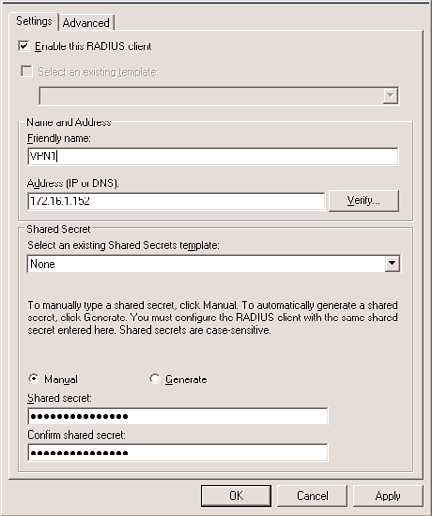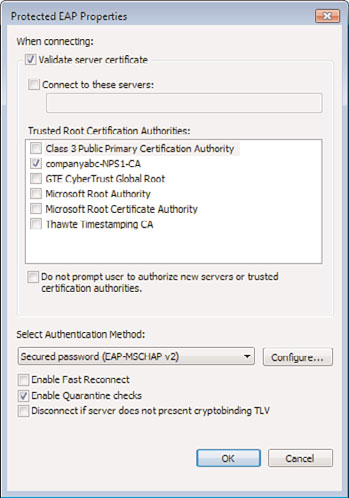Windows Server 2008 R2 Unleashed (173 page)
Read Windows Server 2008 R2 Unleashed Online
Authors: Noel Morimoto

16. Select Microsoft: Protected EAP (PEAP) in the EAP Types window, and click Edit.
17. Verify that the certificate requested earlier in the section is selected based on the
FQDN in the friendly name.
24
18. Click OK to close the window.
19. Click Next at the Configure Settings window.
20. Verify settings to ensure that they look similar to Figure 24.19.
ptg
FIGURE 24.19
PEAP properties.
21. Click Finish to create the connection request policy.
The next step is to configure the RRAS server as a RADIUS client on the NPS system. This
requires using a shared secret password, which in this example is “Secret Password.” To
configure the RADIUS client, execute the following steps:
1. In the Network Policy Server MMC on NPS1, expand the RADIUS Clients and
Servers folder.
2. Select the RADIUS Clients folder and select Action, New RADIUS Client.
3. Enter the friendly name for the client—in this example, VPN1.
4. Enter the FQDN or IP address for the client—in this example, 172.16.1.152, as
shown in Figure 24.20.

886
CHAPTER 24
Server-to-Client Remote Access and DirectAccess
ptg
FIGURE 24.20
RADIUS client configuration.
5. In the Shared Secret text box, enter the secret password Secret Password.
6. In the Confirm Shared Secret text box, enter the secret password again.
7. Select the Advanced tab and check the RADIUS Client Is NAP-Capable check box.
8. Click OK to create the RADIUS client.
The Network Policy Server configuration is now complete on NPS1. The next step is to
create the RRAS server.
Setting Up the RRAS Server
The RRAS server is the entity that will actually connect to the Internet or DMZ, providing
the direct communications with the VPN clients, although the NPS system will be authen-
ticating and authorizing those connections.
The following steps assume that Windows Server 2008 R2 is already installed, that the
VPN1 server is configured with an internal network interface card (NIC; 172.16.1.152) and
an external NIC (192.168.1.201), and that the VPN1 server is a member of the compa-
nyabc.com Active Directory domain. In addition, the network interfaces have been
renamed to Internal and External to reflect their connection.
The next step is to add and configure the Routing and Remote Access role to the VPN server:
1. Launch Server Manager on the VPN server, and select Add Roles in the Roles
Summary window.
Traditional VPN Scenario
887
2. Click Next.
3. Select the Network Policy and Access Services role, and click Next.
4. Click Next.
5. Select the Remote Access Service check box, and click Next.
6. Click Install to install the role.
24
7. Click Close to exit the wizard.
8. Click Start, Administrative Tools, and Routing and Remote Access to launch the
RRAS MMC.
9. Right-click on the VPN server name, and select Configure and Enable Routing and
Remote Access.
10. Click Next.
11. Select Remote Access (Dial-Up or VPN), and click Next.
12. Check the VPN check box, and click Next.
13. Select the Internet-facing network interface—in this example, the interface named
External.
14. Uncheck the Enable Security on the Selected Interface by Setting Up Static Packet
Filters, and click Next.
ptg
15. Leave the IP Address Assignment as Automatically, and click Next.
16. Select Yes, Set Up This Server to Work with a RADIUS Server, and click Next.
17. Enter the NPS system FQDN into the Primary RADIUS Server Name field, which in
this example is nps1.companyabc.com.
18. Enter the secret password in the Shared Secret field, which is the same password
used earlier in the RADIUS Client setup.
19. Click Next and then click Finish.
20. A message box appears, indicating that the properties of the DHCP Relay Agent will
need to be configured. This is because of the selection to automatically assign IP
addresses. Click OK to close the message box.
21. Select the VPN server in the Routing and Remote Access MMC.
22. Select Action and Properties.
23. Select the Security tab.
24. Click on the Authentication Methods button and confirm that Extensible
Authentication Protocol (EAP) and Microsoft Encrypted Authentication Version 2
(MS-CHAP v2) are selected.
25. Click OK to close the Authentication Methods window.
26. Select the IPv4 tab.
27. Verify that the correct adapter is selected for the VPN server to obtain DHCP
services—in this case, the Internal adapter.
28. Click OK to close the Properties window.
The RRAS server is now configured and ready to accept VPN client connections.
888
CHAPTER 24
Server-to-Client Remote Access and DirectAccess
Setting Up the VPN Client
The next step is to set up the VPN client. The four major tasks in this process are as follows:
. Enable Security Center
. Enable the System Health Agent (SHA)
. Configure certificate trusts
. Configure the VPN client
These tasks prepare the client to connect and also validate, enforce, and remediate
health policies.
If the client is a domain member, the Security Center will be disabled. This can be enabled
in the local security policy through the following procedure:
1. On the VPN Client computer, select Start, Run.
2. Enter gpedit.msc and click OK.
3. Expand Local Computer, Computer Configuration, Administrative Templates,
Windows Components, and select Security Center.
4. Double-click on Turn on Security Center (Domain PCs Only).
ptg
5. Select Enabled and click OK.
6. Close the Group Policy Edit tool.
The Remote Access Quarantine Enforcement Client is normally disabled, so it will need to
be enabled on the client. This is done with the NAP Client Configuration MMC
(napclcfg.msc).
1. On the client, select Start, Run.
2. Enter napclcfg.msc and click OK.
3. Select the Enforcement Clients folder.
4. Select the Remote Access Quarantine Enforcement Client. (In Windows 7, use EAP
Quarantine Enforcement Client.)
5. Select Action, Enable to enable the client.
6. Exit the NAP Client Configuration MMC.
The Network Access Protection Agent service is normally set to manual, so it will need to
be started and set to start automatically.
1. On the client, select Start, Run and then enter Services.msc.
2. Highlight the Network Access Protection Agent service, and select Action, Properties.
3. Change the Startup Type to Automatic, and click Start.
4. Click OK to exit the service properties.
For PEAP to function correctly, the client will need to trust the Certificate Authority. This
can be done using automatic enrollment for Active Directory domain members, via the
certificate enrollment site, or manually by exporting and importing the certificate. For this
Traditional VPN Scenario
889
example, we assume that the client is not a domain member and that the certificate needs
to be distributed manually, such as via email.
To export the certificate from the Certificate Authority, execute the following steps:
1. On the Certificate Authority server, select Start, Administrative Tools, and then
Certification Authority.
24
2. Highlight the Certificate Authority (in this case, companyabc-NPS1-CA) and select
Action, Properties.
3. Click on the View Certificate button.
4. Select the Details tab, and click the Copy to File button.
5. Click Next.
6. Click Next to accept the default Export File Format.
7. Enter a name for the certificate (in this case, c:\nps1 ca certificate) and click Next.
8. Click Finish to export the certificate.
9. Click OK to acknowledge the export, and then exit the Certification Authority MMC.
This certificate will be used to certify the NPS1 Certificate Authority to the client, which
will allow the client to trust certificates issued by the Certificate Authority. This will
require that the client import the certificate into the local computer trusted Certificate
ptg
Authority store. To import a certificate into the local computer trusted Certificate
Authority store, do the following:
1. Copy the CA certificate file to the VPN client.
2. Select Start, Run.
3. Type mmc and click OK.
4. Select File, Add or Remove Snap-ins.
5. Select the Certificates snap-in and click the Add button.
6. Select Computer Account and click Next.
7. Click Next to select the Local computer.
8. Click OK.
9. Expand the Certificates (Local Computer) folder.
10. Expand the Trusted Root Certification Authorities folder, and highlight the
Certificates subfolder.
11. Right-click the Certificates subfolder, and select All Tasks, Import.
12. Click Next.
13. Click the Browse button and navigate to the CA certificate file—in this example,
nps1 ca certificate.cer.
14. Click OK.
15. Click Next.
16. Click Next to place the certificate in the Trusted Root Certification Authorities folder.
17. Click Finish and then click OK to acknowledge the certificate installation.
18. Exit the console without saving.
890
CHAPTER 24
Server-to-Client Remote Access and DirectAccess
This allows the client to trust the certificates issued by the NPS1 Certificate Authority. The
next step is to set up and configure the VPN connection on the VPN client:
1. On the client, select Start, Control Panel.
2. Click on Network and Internet.
3. Click on Network and Sharing Center.
4. Click on Set Up a Connection or Network.
5. Select Connect to a Workplace, and click Next.
6. Click on Use My Internet Connection (VPN).
7. Enter the Internet address—in this case, 192.168.1.201. You can also enter the
FQDN vpn1.companyabc.com.
8. Enter a destination name, such as Company ABC VPN Connection.
9. Check the Don’t Connect Now check box, as we will need to configure additional
settings.
10. Click Next.
11. Enter the username, the password, and the domain, and check the Remember This
Password check box.
12. Click Create to create the connection.
ptg
13. Click Close.
14. Click Manage Network Connections.
15. Right-click on the Company ABC VPN Connection, and select Properties.
16. Select the Security tab.
17. In the Security Options window, select the Advanced (Custom Settings) option button.
18. Click the Settings button.
19. In the Logon Security window, select the Use Extensible Authentication Protocol
(EAP) option button.
20. Select Protected EAP (PEAP) (Encryption Enabled) from the drop-down list, and click
the Properties button.
21. Uncheck the Connect to These Servers check box.
22. Check the box next to the previously imported CA certificate in the Trusted Root
Certification window—in this example, companyabc-NPS1-CA.
23. Verify that Secured Password (EAP-MS-CHAP v2) is selected in the Select
Authentication Method drop-down list.
24. Uncheck the Enable Fast Reconnect check box.
25. Check the Enable Quarantine Checks check box. The result should look like Figure
24.21.
26. Click OK to close the Protected EAP Properties dialog box.
27. Click OK to close the Advanced Security Settings dialog box.
28. Click OK to close the connection properties.

